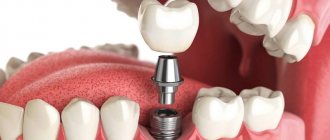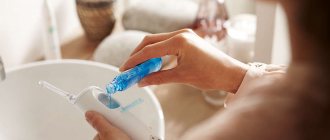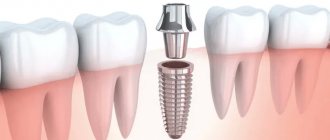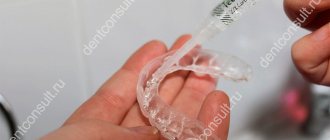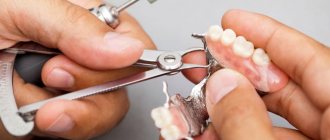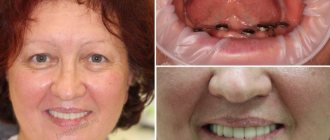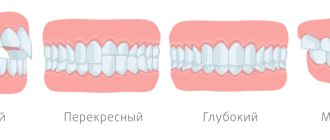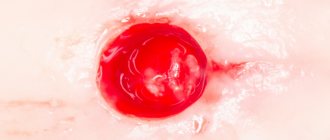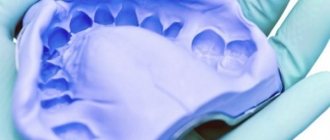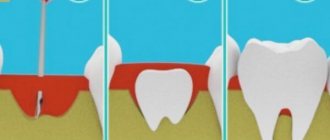A person can lose all or a large number of teeth for various reasons: due to injuries, poor quality treatment, lack of attention to hygiene and dental health. Of course, such a problem as a completely toothless jaw requires an urgent solution, and not only because without teeth a person feels insecure and is embarrassed to communicate with other people.
Missing teeth negatively affects the health of the body as a whole and can lead to:
- To premature aging of the face. In the absence of teeth, facial wrinkles appear much earlier than time;
- To violations of diction;
- To the development of chronic diseases of the gastrointestinal tract. When a person is missing all teeth or a significant number of elements of the dentition, food is not chewed correctly and this leads to disruptions in the processes of digestion and metabolism.
To restore your teeth, you need to go to dentistry, and if you have a completely toothless jaw, you may be offered removable dentures or dental implantation using the All-on-4 protocol as an option for restoring lost dental units.
YOU NEED TO REMEMBER! Removable dentures will allow you to restore teeth inexpensively, but removable dentures cannot be called convenient and comfortable in everyday use. They can rub the soft tissues of the mouth, fall out during eating, active conversation, and cause diction problems. After implantation of all-on-4, a fixed prosthesis is placed on the implants, which is free of all the disadvantages of removable orthopedic structures.
What is All-on-4 implantation, when is this method of dental restoration used, what features will the treatment have? We will answer these questions about All-on-4 implantation in our article. Also in the material you can find up-to-date information on prices for All-on-4 dental implantation in Moscow.
Take a short test and calculate the cost of treatment!
Take a short test
What is All-on-4 implantation?
“All on four” implantation is the fixation of fixed dentures on four implants installed in the upper or lower jaw. The prosthesis is fixed on implants using special screws, which ensures good stabilization. Only a doctor can remove such a prosthesis; this usually happens twice a year - for inspection and necessary preventive measures. The patient’s attendance at such preventive examinations is strictly mandatory, as this prevents the development of possible complications.
Can the screw fastening become loose and the prosthesis fly off...?
Screw fastening is currently considered the most advanced when carrying out both single restorations and when restoring a full row of teeth - this is the most reliable solution. The dentures are attached using small screws - they are inserted into the abutment and implant through the chewing surface of the crowns. The holes are filled from above with a liquid light-curing polymer. This fastening allows, if necessary, to remove the prosthesis, reline it or clean it without damaging the implants.
MYTH
All-on-4 does not have the ability to combine the method of fastening the prosthesis with screws and with cement at the same time.
IS IT TRUE
Yes, indeed it is. But this is an advantage! No one will combine two completely different types of fastening in one prosthesis, because then there is no point in more expensive screw fixation. The prosthesis is placed on the entire jaw and is a complete structure, not assembled into segments. If some part of it is fixed to cement, then it will be impossible to remove it without cutting, even if there is a screw fixation in another area. This means that after such removal, the entire structure of the prosthesis will need to be changed.
Of course, screw fastening has certain disadvantages. In particular, loss of screw fixation may occur. But this phenomenon is extremely rare in good implant systems and most often occurs due to refusal of timely correction or change of the adaptive design to a permanent one, as well as abuse of hard foods. The situation is easily corrected - the screws are tightened/changed.
If you follow all the recommendations of your doctor, undergo timely examinations as part of free service, you will not encounter problems with the integrity of the prosthesis.
What are the indications for All on Four dental implants?
One of the indicators can be the small volume of bone tissue in both the upper and lower jaws. It is especially problematic with the required volume of bone tissue for implantation in the chewing sections, since in the absence of teeth for quite a long time, the volume of bone tissue in these sections decreases, and this happens even when using removable dentures. In order to install the number of implants required for fixing fixed prostheses (from 6 to 10), a preliminary operation is required to restore the required bone volume. Only after this are implants installed, and after some time (from three to eight months) prosthetics are performed on them.
Permanent prosthetics All-on-4 – price and options
All-on-4 permanent dentures can be achieved with different types of permanent fixed dentures. There are a lot of options for permanent prostheses for All-on-4, and it is very difficult for an ordinary patient to understand all their subtleties and nuances. In addition, the choice of prosthesis is determined not only by your aesthetic requirements or financial capabilities, because... In a number of clinical situations, some types of prostheses simply cannot be manufactured.
In addition to the patient’s wishes, the choice of prosthesis will depend on the volume of space for prosthetics (the degree of vertical atrophy of the jaw bone tissue), as well as on the characteristics of the relationship between the upper and lower jaws. For a permanent fixed denture on 4 implants, the price in Moscow and Russia as a whole starts from 150,000 rubles, and this will be the most modest and not very reliable option for a permanent denture. It should be noted that in Russia, in order to reduce the cost of All-on-4, a number of clinics use materials and technologies that have long been abandoned in Europe due to their poor reliability.
Permanent denture options for All-on-4 –
We have already said several times that the All-on-4 technique was developed by Nobel-Biocare (Switzerland), including special types of implants and options for temporary and permanent dentures. In this section, we will first talk about the original options for permanent prosthetics that were developed by Nobel-Biocare, and then move on to a variety of options for prostheses (including non-original economy-class solutions specifically for Russia).
All types of original permanent fixed prostheses for All-on-4 can be divided into two large groups.
- Titanium-polymer prostheses - 90% of permanent prostheses for All-on-4 are made using this technology. Such a prosthesis has a supporting frame inside in the form of a titanium beam, individually manufactured for each patient - by milling on a computer-controlled machine (CAD/CAM technology). The outside of the beam is lined with acrylic plastic or ceramic composite, from which the base of the prosthesis (artificial gum) will be made + artificial teeth will be installed in the base of the prosthesis (Fig. 16-17).
If you are focused on quality, then it is better to choose original solutions - these are only titanium beams from Nobel-Procera, although non-original beams from other manufacturers can also be used (they will be a little cheaper). Modern beams are not made smooth - they have retention projections that act as supports for artificial teeth. The best option is probably the “NobelProcera hybrid beam”, which has no analogues from any company, not even Straumann.
But! Titanium-polymer prostheses require a lot of vertical space for prosthetics, and therefore, if the patient has only a slight degree of atrophy of the jaw bone tissue, these prostheses simply cannot be manufactured. In this case, we will offer the patient only bridges made of zirconium dioxide or metal ceramics.
- Bridges can be the familiar metal-ceramics or metal-free ceramics (zirconium dioxide). In both cases, the bridge frames will also be manufactured by milling using CAD/CAM technology. The original frame for a metal-ceramic bridge is made of titanium, the artificial teeth will be made of zirconium dioxide, and if artificial pink gum is needed, it will be made by applying a ceramic mass (Fig. 18).
The frame of the ceramic bridge will be made of zirconium dioxide, the artificial teeth will also be made of zirconium dioxide + if necessary, the prosthesis can also have pink artificial gum made of ceramic (Fig. 19). This is the best option for a prosthesis in terms of aesthetics, and in the photo below you can see how accurately it imitates the gums and teeth on the lower jaw, which are difficult to distinguish from real ones (Fig. 20).
Important: original All-on-4 prosthetics involves the use of only Nobel-Procera titanium bars and bridges. But it won’t be a problem if your clinic uses non-original milled frames made on similar equipment from other companies. But what’s really bad is when Russian dental clinics offer economical options for prosthetics, for example, when instead of a milled titanium beam, a cast beam made of nickel-chrome alloy is used. Or when metal-ceramics are made on a frame made of cobalt-chromium alloy (CHS), even by milling.
Such solutions make it possible to reduce the cost of All-on-4, but this reduces the strength of the prosthesis frame by at least 5 times, and in addition, the use of cast beams greatly impairs the accuracy of their fit on the installed implants. Another disadvantage is that cast nickel-chrome beams and CCS frames have a significantly greater mass (compared to titanium), which significantly increases the weight of the prosthesis and makes it difficult to get used to it.
What are the advantages of dental prosthetics with 4 implants?
If we compare the “All on Four” technique with the use of removable dentures, the difference will be that in the first case the risks of mucosal injury, bone loss, as well as difficulties with fixation and correction are reduced to zero.
A patient with a removable denture experiences discomfort both functionally and socially. Most people who use removable dentures experience some self-doubt, and sometimes even inferiority in their social status. Also, when installing “all on four” implants, as already mentioned, there is no need for a large number of implants. Due to the fact that these four implants are installed in certain positions in relation to each other: when implanting the front teeth - straight, and in the lateral teeth - at an angle of 35º to 45º, and also by creating a large distance between them, the chewing load is adequately distributed and is redistributed during operation. A small number of implants simplifies the operation, making it faster and more predictable, while ensuring excellent results.
Prosthetics of frontal units
Prosthetics of anterior teeth is a complex process from a technical point of view. It requires the doctor to take special care in carrying out each manipulation, since as a result the patient hopes to receive an exact copy of a healthy tooth with the appropriate shape, shade and strength. Progressive prosthetic methods allow you to achieve ideal results
in recreating the integrity and beauty of the frontal zone.
For high-quality restoration of segments in the smile area, three crown options are used, which are the most acceptable, both in terms of strength and aesthetics, for replacing natural segments:
- Zirconium.
- Ceramic.
- Metal-ceramic.
If it is necessary to install dentures on the front teeth, crowns made with ceramic or zirconium are first considered. The fastest and most promising option is an orthopedic crown on a tooth using CEREC technology. You can get an attractive smile in just one visit. However, it is also the most expensive. A compromise in this case could be a metal-ceramic prosthesis.
A turnkey metal-ceramic tooth crown is an excellent combination of price, quality and aesthetics. The only drawback is the metal base; it can be visible through the ceramics. But the defect is noticeable if the crown is on only one segment. If you plan to install a crown on four or six front teeth
, it will be difficult to distinguish natural teeth from dentures.
Today, very often, patients no longer choose metal-ceramics, but e-max or cerec ceramics, which not only do not have the disadvantages of metal-ceramic crowns, but also look aesthetically more beautiful.
Classic dental prosthetics, regardless of the location of the crown, is carried out in stages.
What types of prostheses are used when implanting All-on-4?
For “All on Four” implantation, fixed prostheses are always used, which, however, can be called conditionally removable, because they are fixed with special screws, but at the same time they are fixed rigidly. The patient is not able to remove them while wearing them; I repeat, this can only be done by a doctor for regular checks.
Designs of this type have stood the test of time, showing excellent clinical results. The reliability of work done using this technology is beyond doubt. A large number of patients choose this technology and are very satisfied.
Two methods of prosthetics for front teeth for caries:
1. The crown on the front teeth is attached to a pin
– a miniature screw rod is screwed into the sealed root canal. Filling material is applied to its upper part, ground to the required size, and a crown is installed. But again, pins are gradually being replaced by the more patient-friendly CEREC technology. And patients come to me with problems with previously installed pins with the goal of replacing them with a single dental module, as in the following video:
2. Crown on the front tooth using a stump inlay
– this element is made in the laboratory. Outwardly, it resembles a tooth stump. It is securely attached to the root canal and the prosthesis is securely fixed on its upper part (stump). But, despite its popularity, the stump inlay has one significant drawback - it forms an additional adhesive connection both with the tooth tissue and with the crown being installed. This can be avoided by restoring the front teeth using CEREC technology. When using Cerec technology and using “root + crown” type modules, we reduce the gluing points to just one:
Installation of dentures using “root + crown” modules on the front teeth increases the service life of the crowns. In addition, they allow you to create the ideal tooth shape, which is important when replacing teeth in the smile area.
Preparation for implantation using All-on-4 technology
No special preparation is required, but if there are foci of infection in the planned location of the implants that can affect the quality of the intervention, they require preliminary relief. If there are roots of decayed teeth or loose teeth in the oral cavity, they are removed during surgery.
Before the operation, the patient must undergo examination: blood tests, X-ray diagnostics. If everything is in order and the patient does not suffer from systemic diseases, including diseases of the blood and immune system, he can safely count on this operation. We usually offer different types of implantation, but with such a defect as the complete absence of teeth in the upper or lower jaw, “all-on-four” implantation always wins: both in terms of treatment cost and time savings.
When compared to removable dentures, which is better?
To fully appreciate the advantages of the all-on-4 system over various removable prosthetic options, we will conduct a brief comparative analysis. The key advantages of a prosthesis on implants compared to installing a removable structure are shown in the table below.
| All-on-4 | Removable prosthetics |
| Comfort and reliable fixation of the prosthesis - the structure is attached with a screw method, and only a dentist can remove it. This allows the device to be securely held in the oral cavity, and the patient will not have to worry that it may move at the most inopportune moment. | Removable dentures do not provide adequate fastening strength, especially when it comes to full construction. Patients complain of frequent anxiety that the device is about to fall out of their mouth while talking or eating; they have to additionally use fixing gels. |
| Stopping atrophic processes in bone tissue - implants become full-fledged substitutes for tooth roots, transferring the chewing load to the jaw bone, in which metabolic processes are resumed. This allows you to stop the atrophy of bone tissue and literally bring it back to life, and in the coming days after installing the implants. | Bone atrophy is an inevitable phenomenon that occurs when even one tooth is missing. At the same time, neither a removable structure nor a bridge can protect the jawbone from gradual resorption - this process can only be stopped with the help of implants. |
| Maintaining the level of the gums - during the operation of the prosthesis on implants, the gums do not sag, do not expose the roots of the teeth, and maintain an aesthetic appearance. | The gums sag, exposing the cervical area of the teeth, and all this negatively affects not only aesthetics, but also the health of the mucous membrane in general. In addition, removable appliances often rub the gums, injure soft tissues, and microscratches can lead to infection. |
| Aesthetics – a prosthesis with an acrylic base hides all defects in the mucous membrane, and artificial crowns made of plastic, ceramic composite or zirconium allow you to choose a shade that exactly matches the natural color of the teeth. | Modern manufacturers offer quite aesthetic solutions for removable prosthetics, but they can hardly compete with implant-supported dentures. In addition, most patients admit that they have complexes with such devices in their mouths due to the fear that the structure will fall out at the wrong time. Problems with diction and facial expressions appear, and the person stops smiling openly. |
| Protection against aging - the design, almost immediately installed on implants, activates the work of the facial muscles, restores their tone and protects them from deformation due to prolonged absence of teeth. | Removable dentures do not protect against aging - the absence of teeth, even with such structures, leads to the gradual formation of wrinkles, recession of the cheeks and lips, which is why the patient looks older than his age. |
With all-on-4 implants, patients can choose between a less expensive option with a metal bar and plastic crowns or a more expensive model with porcelain composite crowns and a custom titanium bar. The second prosthesis is placed immediately and almost permanently. Its actual service life is estimated at decades, and in most cases the design does not require re-prosthetics.
All-on-4 implantation technologies
This operation, in its essence, differs little from a number of similar implantation operations. Its only difference is that after installing the implants, provided they have good primary fixation, they immediately begin to “work.” This means that they can either be immediately fitted with a new fixed prosthesis, or the patient’s old (removable) prosthesis can be fixed, making it permanent. This manipulation usually takes about 3 - 4 hours. The mucous membrane, injured during surgery, does not suffer at all, since the load is not distributed on it, but directly on the installed implants. In fairly complex cases, when the volume of bone tissue is minimal, the patient will be advised to make an individual template made in 3D format based on a tomogram image. At the preparatory stage, the doctor plans the route of insertion of the implants into the jawbone, and only then during the operation they are installed using a manufactured template. After 4-6 months, during which a temporary fixed prosthesis is used, a permanent fixed prosthesis is made that will last for many years.
Photos before and after All on Four implantation
If the prosthesis is placed on the day of surgery, the gums will be injured
Adaptive prostheses for All-on-4 prosthetics are installed within 4-8 hours or on the 3rd day. In the first case, they are frameless, in the second - with a metal base for additional splinting of installed implants. Firstly, such prostheses are very light. Secondly, they are securely fixed on the implants, that is, they do not move under load, which means they do not touch the gums or injure them, and do not interfere with the full healing of the mucous membranes. Thirdly, their interior is very smooth and highly polished. That is, there can be no talk of any injury.
MYTH
Instant loading with a prosthesis impairs the healing of gums that have sutures; it is better to wait at least 3 days.
IS IT TRUE
Instant load, on the contrary, improves engraftment due to improved blood supply and high-quality lymphatic drainage. Metabolic processes are initiated optimally. In addition, self-absorbable barrier membranes are applied during the period of primary healing of soft tissues, which eliminates the additional risk of infection and inflammation.
In addition, the neck and upper body of Nobel Biocare implants are covered with an anodized gold Xeal™ surface, which ensures the integration of soft tissues with the implant, which subsequently creates a reliable barrier against the microbial environment entering the bone tissue and significantly reduces the level of gum and marginal bone loss.
Historical fact! Nobel Biocare are the first in the world to thoroughly develop the era of mucointegration, that is, to create implants with which not only bone, but also periodontal tissue is integrated.
The word “mucus” itself translated from Latin means “mucous”. Accordingly, in this context, mucointegration means the process of combining the implant with the mucous membrane. More precisely, the creation of maximum tight contact (adhesion), resulting in the formation of a barrier that protects the adjacent bone. And this is the key to a long service life of installed implants.
The level of keratinized (attached or upper part) gums with abutments with a Xeal surface is almost 2 times higher than with other systems
Naturally, during the first week, when tissue restoration occurs, the patient requires more gentle nutrition (more details can be found here), drug therapy, and high-quality hygienic care are important. But there will be no pain or acute discomfort. If the unpleasant sensations persist, there is a feeling of contact between the prosthesis and the gums, you can contact your doctor at any time to correct the structure.
Are there any complications after the procedure?
Complications, of course, occur, for example, such as a fracture of the base of the prosthesis, but this can only happen with a temporary structure. With permanent restoration this is unlikely to happen. Also, at the early postoperative stage, inflammation of the mucous membrane may occur, but in the future, the formed mucous membrane remains healthy with proper care. The worst thing that can happen is perimlantitis - inflammation of the tissue near the implant caused by the appearance of pathogenic microbes between the implant and the bone tissue that holds it. That is, in essence, this is the destruction of the bone fragment that holds the implant. However, with careful care and good oral hygiene, in particular denture hygiene, this will not happen.
Degree of reliability of the entire system
Nobel products rightfully occupy a leading position in the international market of implantological systems. Implants and their components undergo complex clinical studies before they are included in the manufacturer’s open range. The products meet the highest standards of quality, safety and efficiency, and the manufacturer itself provides a lifetime warranty on its products. You don’t have to worry about the reliability of the structures, but it’s worth remembering that the success of the implantation also depends on the patient himself, on how conscientiously he follows the doctor’s recommendations and takes care of his oral cavity after the operation.
